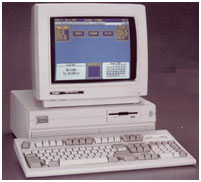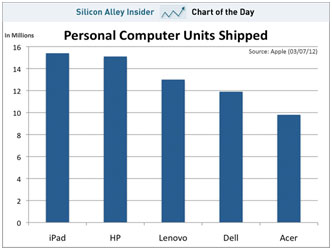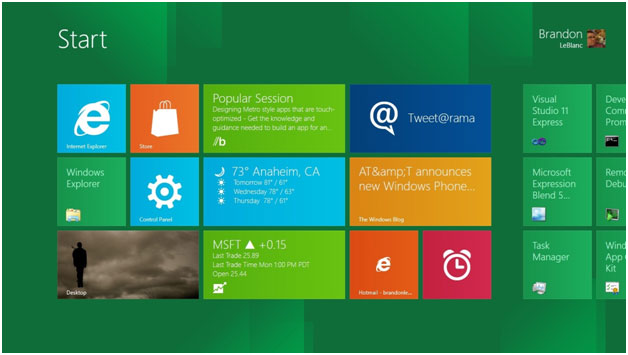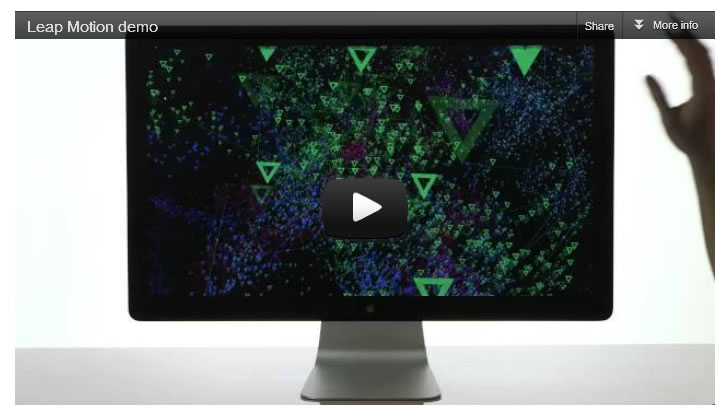Is the Generational Divide in Technology Widening?
Companies / Technology Jun 07, 2012 - 12:15 PM GMTBy: Casey_Research
 Alex Daley, Casey Research writes:
My son doesn't know how to use a mouse.
Alex Daley, Casey Research writes:
My son doesn't know how to use a mouse.
He doesn't even know what one is. As far as he's concerned, it's a furry animal he's only seen in books and running around the floor of the Newark airport.
While I've known this for some time, it recently moved from the back of my mind to front and center following a brief car trip a few days ago. From the back seat, my eldest son – who for some inexplicable reason loves to watch the instructions tick by on the screen of the GPS unit sitting on the dashboard – requested that I program the unit to give us directions home. I politely declined, pointing out that I couldn't be messing around with the screen as I was already driving. He followed up with that well-known, youthful naïveté that borders on soul-piercing in its effectiveness to point our shortcomings in ourselves and our world by asking:
"Why can't you just tell it where you want to go? Like the Xbox."
"I don't know, son…"
Unhappy with the answer he'd received, the conversation then turned in the direction of endless questions about computers versus video games versus the car's GPS. In all the hubbub of explaining to my eldest about the differences between them, especially how we interact with them, my youngest, despite spending many an hour on particularly snowy Vermont days upstairs in the home office playing Curious George games on the computer, piped in abruptly:
"Dad! Why would your computer have a mouse in it?! You're just making that up!"
A lot has been made over the past few years of so-called "digital natives" – children who were born and raised in the age of the computer. Kids like Mark Zuckerberg, who was born in 1984, seven years after the release of Apple's first computer. For all of his life (and mine; if I'm being honest, I'm not that much older than Zuck), computers have been part of human existence.
We were both part of the first digital generation. But still, even then the computer was something distinct from everyday life. It was culturally defining. It was epochal, some might even say. But it was by no means universally prevalent.
One of my fondest childhood memories is of the arrival of a fresh, new Tandy 1000 SL one Christmas morning. I remember it well. 50-odd lb., 13-inch CRT monitor. Big honking base "CPU." Keyboard… and no mouse. That came later, with the next-generation model.

The arrival of the Tandy was the moment we went from a family without a computer to a family with one. I look back at it, and I like to think it compares to the arrival of the first television set in many households in the 1940s and 1950s. The family gathered around the set to watch Ed Sullivan, neighbors aglow with jealousy.
We were by no means the first on the block to own a computer. Still, at that stage many a family didn't yet have one. Maybe Dad or Mom used one at work, and of course, our small suburban school had a little "lab" of them, used to mainly to teach typing. So I'd used them before, on occasion, but the power of the device – and my borderline addiction to it – was not apparent until it invaded the home. Or at least my home (there is probably a good "nature vs. nurture" debate in the evolution of the computer geek).
But it wasn't much like the arrival of the television at all. I only found out years later that my mother had to work hard to convince my father that it was more than his choice description – "a $3,000 pet rock." We never huddled around the phosphorescent glow of the screen as a family. My brother ignored it nearly entirely (maybe that was only because I hogged it?). The same was true for the majority of children in the original group of digital natives: the computer was part of, but mostly peripheral to, the average child's life. It was only a select set who really made it a part of their everyday lives.
Yet today that seems to have changed, simply by the ubiquity thrust upon the current generation of children. Computers, in the looser definition of the word that includes smart phones, tablets, traditional PCs, interactive video players, GPS devices, game consoles, and a host of other consumer and business tools and toys, are everywhere. Our car stereos become speakerphones and road maps on demand. We even use touchscreens to order lunch at deli chains and burrito joints. Living a day free of interaction with a computer is now much more difficult than it was for the first digital cohort.
Quantifying the impact of this generational shift is difficult, if not downright impossible. But we can garner quite a bit of insight from the anecdotal experiences we have with our own children today. I am a father of two wonderful sons, ages four and six. As you can imagine, given my geekish tendencies and a career centered on being up to date on some of the most advanced technologies around, my home is replete with the latest gadgets – everything from the run-of-the-mill consumer electronics to quad copters and 3D printers.
Amongst the most prized of those gadgets (from the perspective of my six-year-old at least) are the video game consoles. We have a Wii, a Playstation, and most notably for this story, an Xbox with the Kinect attachment, hooked into the surprisingly modest-sized television in the living room. (I've never been a prime time TV or sports addict, so a TV bigger than the 37-inch LCD is one of those things I occasionally think of grabbing, but never bother to.)
For those of you unfamiliar with it, the Xbox with Kinect allows you to eschew the traditional joystick and instead use gestures to control the game. No controllers. No remotes. Just stand in front of the three-eyed digital camera contraption and it senses where your head, heads, feet, etc., are and where they are moving to. The resulting paths of motion are translated by the console into swipes that slide content along the screen, kicks that send virtual soccer balls flying, and (thanks to some munificent math by game designers) Olympic-record-breaking long jumps you'd never be capable of in real life.
The Kinect is not the only sensing device on the market. The video below highlights another one, the Leap Motion:
This video shows the power of these devices firsthand. Like the Kinect, like the multi-touch screens of the iPhone, iPad, Androids, and other devices, the Leap Motion captures far more than just the location of a single dot. Instead it maps a wide variety of motions onto a map of intended actions. It attempts to allow for natural gestures to become the language in which we communicate with our computers.
It's not uncommon these days for kids to experience computing without the traditional tethers of keyboard and mouse, or even remote controls and game controllers. These novel, unwired interfaces are not only coming to market, they are on the verge of becoming ubiquitous.
Take another keyboard- and mouse-free device for instance: the iPad. Just a little over two years after its introduction, the touchscreen-centric iPad is the number-one selling non-phone personal computer in the world. It outsells – in sheer volume of units shipped – the total of all computers shipped by any one of the top PC makers in the world: HP, Dell, Lenovo, etc. That's all their many models of desktops and laptops rolled into one:

Or consider the iPhone, which is the number-one selling phone in the world, hands down. Its next closest competitors virtually all sport touchscreens as well. Now, 50% of all phones sold in the US are smartphones, and virtually all are powered by touchscreen interfaces.
But iPad- and iPhone-like touch-based devices are just supplements for most households in the developed world (in developing nations, like most in Africa and large swaths of Asia, increasing numbers of households count their smartphones as the first and sole computing device). In the West, the touchscreen-centric devices add to their owners' computers, but still rarely wholesale replace them. The Western world, even at home, is still dominated by Windows and traditional Macs.
However, recently Microsoft announced that its Windows 8 desktop operating system, due out this fall, will be fully touch enabled. In other words, its interface will look much more like the iPhone than it does the traditional Windows interface hundreds of millions of people know today. In fact, it will look exactly like the interface on the new Windows phones, dubbed "Metro."

The sleek, tile-based interface is meant to work on touch screens that vary in size from phone to wall uses. And all at the tip of your fingers. The multi-touch revolution is literally remaking the computer as we know it. And more and more often, users – children especially – will be able to simply eschew the mouse and even the keyboard.
That's because it's not just touch that Microsoft is eyeing. The same gesture and voice technologies that control the Xbox will also be brought to Windows 8 as well.
The company already produces a Kinect for Windows, and hackers have been busy working on connecting the device to older versions of Windows and to a whole host of other devices, including robots:

With devices like the Leap Motion following the Kinect, gestures may someday become as common as the touchscreen is today.
You'll be able to use your machine's microphone to control it as well. Microsoft already brought speech recognition to cars with Ford and Fiat's infotainment systems, and now it plans to make it ubiquitous in every device it touches.
We've just begun what promises to be a wholesale revolution in the way we interact with computers, as big or larger than the introduction of the mouse and graphical user interface, yet already, the first crop of these devices is beginning to change the entire way we think about interacting with computers, from top to bottom.
First, it's not that we have "a" computer; we now have multiple computers. And they carry names like "phone," "tablet," and "Xbox." With each, we touch the screens, talk to them, wave at them, and expect them to understand what we're doing. Increasingly, they even interact back with us through speech or by navigating our physical world.
By the time my sons reach 8 and 10 – I was 10 when I received my Tandy, which came standard with a 256-color video graphics setup that I thought was pretty awesome at the time – the term "click here" will have about as much personal relevance to them as "turning" the channel or "dialing" the telephone.
The fact that I had to "sit down at the keyboard" to type up this message is even a half-truth. I've been bitten by the speech recognition bug, and the majority of what you read here was spoken aloud to my computer, which did the typing for me, whilst I paced around my office.
For me, that's still novel. But for my sons, who have known nothing different in their short lives, gestures and voice controls and touchscreens are so common that they now expect as much from every new device they encounter. To them, it makes no sense that they cannot just talk to the GPS (something which, now that it's been pointed out to me, seems equally preposterous given its position inside the car where inevitably both of my hands will be otherwise occupied at the 10 and 2 positions on the steering wheel).
The touchscreen is for them – sons of a geek – the lowest common denominator. Everything does that. Speech? Gestures? Why not?
User interface expectations are built very early on. Painted on the blank canvas that is a screen, they often come to be based on metaphors we know from our previous lives. Once comfortable with the way things work, it takes a pretty large benefit for us to change our behaviors (if that were not the case, the iPad onscreen keypad would have used the Dvorak layout, which has been proven time and again more efficient for typers than the QWERTY keyboard, which was invented to minimize mechanical movement and thus repairs of mechanical typewriters – like the metric system for most American people, it's just not enough better to make it worth even considering).
It is likely for this exact reason that, despite my penchant for gadgets, we still live in an iPad-free household. It's because Dad (i.e., me this time) doesn't like the thing. I find it terribly constrained. I cannot bear to type on the screen. There's no easy way to position the screen to a good angle. But most of all, I hate not having a file system where I can download a presentation and leaf through it, making small changes, adding slides, etc. The idea that a computer doesn't contain folders and files is as foreign to me as the lack of voice control in the car's GPS system is to my sons.
Luckily, as one of the technological one-percenters from my own, original digital-age group, adjusting is easier for me than for most.
I almost never thumb in a message on my Android phone. I rely instead on the excellent voice recognition built in (I only wish there was a button on the phone to hold to put it into voice mode, like on the iPhone).
I use the Kinect voice controls regularly... so much so that given the choice between hopping around the nice "Metro" interface of the Xbox with my voice commands and trying to surf through cable channels, I end up watching "reruns" (another of those archaeologically rooted technical terms) on Netflix, via the Xbox, every single time. (Bonus: I never have to find that darned remote again!)
My youngest son, sneaking upstairs for some additional fun with Curious George's online games, has (largely unnoticed by me until now) made the same choice with the computer in my office. He's elected to exclusively use the giant touchscreen I installed up there – as a geeky thing for me to explore and mostly never use – as his sole input device. To him, the mouse on the desk might as well be the furry little creature, as it is has just as little to do with the computer as its mammalian namesake.
No, for my two young sons, their Tandy moment will not involve a black screen with blinking cursor. They may not even have a Tandy moment; or they may have had many much smaller ones already. Maybe, just maybe, they may never even know what it's like to understand a colossal leap forward in technology stepping into their lives seemingly overnight. After all, for them, computing is already an immersive experience – one where you interact with dozens of devices, each purpose-built for its task, each designed to work around you, rather than you having to bend to their somewhat quirky and limited means of interaction.
While members of my generation were the original "digital natives," things will look much different viewed through the eyes of our own children. What to expect of computers has changed in a seeming flash. But still, the geek in me knows deep down that it is precisely because many of the most inclined in their generation – like me, Zuck, and millions of others in the prior age cohort – will be as frustrated by the limitations of what today's adults dreamt up that they too will work to throw them out and replace them with something even further, inspired not by Star Trek, whose vision of the user computer interface wasn't much beyond what's in the Xbox and iPad, but maybe by Ready Player One… or even Harry Potter.
The implications of this trend loom large for investors as well. The new paradigm for computing is about natural interaction. And any company that ignores it will ultimately limit its market going forward. PCs ate the mainframe. The Blackberry destroyed the mobile phone. The iPhone wiped out the Blackberry. The Xbox trounced the Wii. What will the next major shift in the interface bring? Time will tell, but our experiences thus far suggest the mouse will likely play a lesser role, and our hands, voices, and maybe even just our minds will play a much larger one.
I'm excitedly awaiting the arrival on my doorstep of a novel "learning" thermostat (yes, I'm that kind of geek). Just adjust the temperature by turning the dial as you go in and out, as you wake and get ready to sleep, and it learns your patterns, creating a constantly adapting program to both make you comfortable and save energy. It adjusts to weekends – it knows what date and time it is. The weather – it knows where you live. When you aren't home – it has motion sensors. Cool stuff.
But when it arrives, I am sure my son will ask why I have to "turn the dial" in the first place. Why can't I just tell it to make it cooler? Why not, indeed…
As amazing as these advances are, they all are driven by the brilliant individuals whose visionary dreams guide their work. To be in on the companies most likely to survive the stiff competition in tech, an investor must understand this and keep up with the ever-shifting front lines of the tech wars.
© 2012 Copyright Casey Research - All Rights Reserved
Disclaimer: The above is a matter of opinion provided for general information purposes only and is not intended as investment advice. Information and analysis above are derived from sources and utilising methods believed to be reliable, but we cannot accept responsibility for any losses you may incur as a result of this analysis. Individuals should consult with their personal financial advisors.
© 2005-2022 http://www.MarketOracle.co.uk - The Market Oracle is a FREE Daily Financial Markets Analysis & Forecasting online publication.




